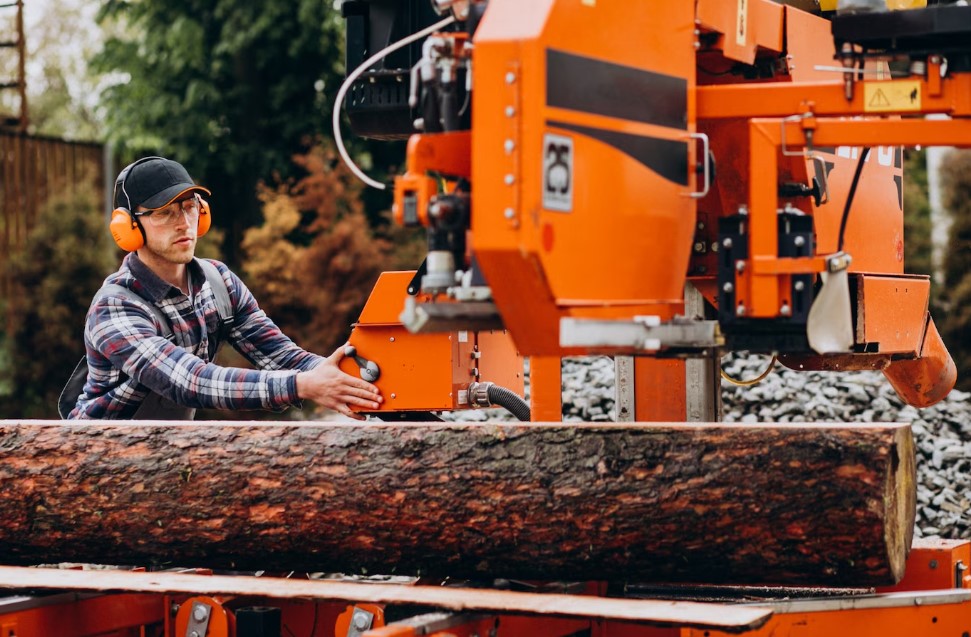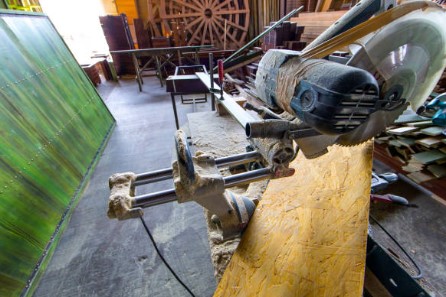Unveiling the Mechanics: How Do Wood Chippers Work?
You may have asked yourself the question, “how do wood chippers work?” It is really the fascinating process of how wood chippers work efficiently to transform branches and limbs into useful mulch or chips. Whether you’re a homeowner, landscaper, or just curious about technology, understanding the mechanics of wood chippers will empower you to make well-informed decisions, maintain them effectively, and gain insights into their environmental benefits.
How Do Wood Chippers Work Smoothly And Effortlessly?
Operating a wood chipper doesn’t have to be daunting. This section provides step-by-step instructions and essential tips to ensure a seamless and effortless wood chipping experience. From starting the machine to adjusting the settings, you’ll gain the knowledge needed to handle the wood chipper like a pro.

Preparing the Worksite and Safety Checks
Before diving into wood chipping, proper preparation and safety checks are crucial. This section outlines the necessary steps to create a safe and efficient worksite.
Learn how to clear the area, inspect the chipper for any issues, and implement safety measures to protect yourself and others during the operation.
Proper Handling of Wood Materials
Knowing how to handle wood materials correctly enhances the chipper’s performance and minimizes the risk of accidents. In this section, we’ll cover the best practices for loading the chipper, choosing the right wood for chipping, and maintaining a steady workflow. Master the art of feeding the machine to maximize efficiency and produce high-quality wood chips or mulch.

Understanding the Control Panel
The control panel is the nerve center of the wood chipper, dictating its functions and capabilities. This section provides a comprehensive breakdown of the control panel’s features, explaining each button, lever, and gauge.
By understanding the control panel, you’ll gain full control over the wood chipper, optimizing its performance and ensuring a safe and efficient chipping process.
Adjusting the Chipping Settings
Fine-tuning the chipping settings is essential to achieve desired outcomes based on specific wood types and project requirements. Here, we delve into the various chipping settings and how to make precise adjustments. Discover the ideal settings for different wood materials, and learn how to optimize chip size, feed rate, and cutting mechanism for superior results.
Operating the Wood Chipper on Sloped Surfaces
Chipping wood on uneven or sloped terrains demands special considerations. In this section, we cover the essential techniques and safety measures for operating a wood chipper on sloped surfaces. From stability concerns to maneuvering tips, you’ll gain the knowledge needed to handle sloped terrains with confidence and efficiency, ensuring a smooth and secure chipping process.
The complex mechanisms involved in wood chippers’ operation
Wood chippers are intricate machines that rely on a combination of sophisticated mechanisms to efficiently transform wood into chips or mulch. This section delves into the inner workings of these powerful devices, unraveling the various mechanisms responsible for their smooth operation and high-performance chipping capabilities.

Blade System and Cutting Mechanism
At the heart of every wood chipper lies its blade system and cutting mechanism. This subsection explores the types of blades used, their arrangement, and the principles behind their cutting action. Understanding how these components work together will provide insights into the chipper’s ability to process wood effectively and produce consistent, quality results.
Feeding Mechanism
Efficient feeding of wood into the chipper is vital for optimal performance. This section covers the feeding mechanisms employed by wood chippers, including gravity-fed and hydraulic systems. Discover the importance of a steady and controlled feed rate to prevent jams and maximize throughput.
Chipping Chamber and Compression Mechanism
The chipping chamber is where the magic happens, where wood gets transformed into chips. Here, we explore the design and function of the chipping chamber, along with the compression mechanism that aids in breaking down wood materials. Gain insights into how these components work together to create uniform and high-quality wood chips.

Discharge Mechanism
Once the wood is chipped, the discharge mechanism plays a crucial role in efficiently ejecting the chips from the machine. This subsection examines the different types of discharge mechanisms and their significance in ensuring continuous operation and easy collection of the chipped material.
Hydraulic System and Control Mechanism
The hydraulic system serves as the lifeblood of many wood chippers, powering various functions and providing versatility in operation. Here, we explore the role of hydraulics in controlling the feeding, cutting, and discharge mechanisms. Understanding the control mechanism allows operators to tailor the chipper’s performance to specific needs.
Safety Considerations
Wood chippers can be valuable tools for homeowners, landscapers, and other professionals dealing with yard waste and wood debris. However, before diving into the decision to purchase a wood chipper, it’s crucial to assess whether it’s worth it for your specific needs.
Consider the volume of yard waste you generate, the frequency of use, and the potential cost savings from turning waste into mulch or chips.
When assessing whether a wood chipper is worth the investment, it’s essential to weigh the benefits against the potential dangers. Wood chippers are powerful machines with sharp blades, and they can be dangerous if not used properly.

When choosing a wood chipper, prioritize safety features and user-friendly designs. Look for models with emergency shutdown switches, safety curtains, and proper blade enclosures to minimize the risk of accidents. Additionally, consider the chipper’s capacity, engine power, and ease of maintenance.
If you’re uncertain about the best fit for your needs, seek advice from experts or consult with reputable dealers who can guide you in selecting the most suitable wood chipper for your requirements.
In conclusion, safety should be the top priority when dealing with wood chippers. Make an informed decision by carefully examining the potential benefits and risks that come with the purchase.
Maintenance and Care
Proper maintenance is essential to keep a wood chipper running smoothly and safely. Understanding how a wood chipper works will give you insights into the maintenance requirements. Regular maintenance tasks include checking and sharpening the blades, inspecting and lubricating moving parts, and cleaning the chipping chamber.
Operating a wood chipper requires adherence to safety guidelines to prevent injuries and accidents. When using the machine, wear gloves, safety goggles, and ear protection to stay safe. Familiarize yourself with the emergency shutdown mechanism and be prepared to use it if necessary.

Considering whether wood chippers are worth the investment depends on your specific needs and circumstances. If you have significant amounts of yard waste regularly and can make use of the resulting mulch or chips, a wood chipper can be a valuable tool.
A wood chipper shredder combines the functions of both chipping and shredding wood materials. It incorporates additional mechanisms to process wood waste into smaller pieces suitable for composting or mulching. This versatile machine can efficiently handle a wider range of wood debris and enhance your waste management capabilities.
Therefore, maintaining and caring for a wood chipper is vital for its safe and efficient operation. Prioritize safety by wearing appropriate gear and operating the chipper responsibly. Assess your specific needs and the potential benefits of owning a wood chipper before making the investment.
FAQs
How do wood chippers work, and what is their primary purpose?
Wood chippers work by using a powerful engine to drive a cutting mechanism, typically comprising sharp blades or knives. The primary function of a wood chipper is to efficiently transform branches, limbs, and other woody materials into smaller pieces, such as wood chips or mulch. These processed materials can be used for various purposes, including landscaping, composting, or as biomass fuel.
What are the main components of a wood chipper, and how do they function?
The main components of a wood chipper include the engine, feeding mechanism, cutting mechanism, chipping chamber, and discharge mechanism. The engine provides the power to drive the chipper’s functions. The feeding mechanism guides the wood into the chipping chamber, where the cutting mechanism shreds it into chips. The discharge mechanism expels the processed material from the machine.
How does the cutting mechanism in a wood chipper produce wood chips?
The cutting mechanism typically consists of multiple sharp blades or knives mounted on a rotating disk or drum. When wood is fed into the chipping chamber, the rotating blades slice and cut the material into small chips. The design and positioning of the blades ensure an efficient and uniform chipping process.
What types of wood materials can be processed through a wood chipper?
Wood chippers can handle various types of wood materials, including branches, limbs, twigs, and small logs. Softwood and hardwood materials can be processed, but it’s essential to consider the chipper’s capacity and power to handle larger and denser wood pieces.
Are wood chippers easy to operate for beginners?
While wood chippers are user-friendly, they require some knowledge and practice to operate safely and efficiently. Beginners should thoroughly read the manufacturer’s instructions, familiarize themselves with safety guidelines, and start with smaller, manageable wood pieces before moving to larger materials.
Conclusion
This article helps you answer the question “How do wood chippers work?”. That enables informed decision-making, improved efficiency, and appreciation of the environmental benefits of wood chippers in turning waste into a valuable resource.
Related Articles